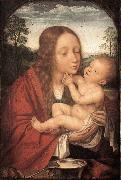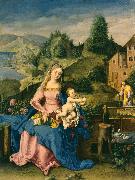Wholesale Oil Painting No Minimum |
|||||||||||
|
|
|||||||||||

|
|||||||||||
|
|
|
||||||||
Quentin Massys1464-1530 Flemish Quentin Massys Galleries Quentin Matsys, his first name also recorded as Quinten or Kwinten and his last name as Massys, Metsys, or Matsijs (1466 - 1530), was a painter in the Flemish tradition and a founder of the Antwerp school. He was born at Leuven, where he was trained as an ironsmith. Near the front of the Cathedral of Our Lady in Antwerp is a wrought-iron well, known as the "Matsys Well," which according to tradition was made by the painter-to-be. During the greater part of the 15th century, the centres in which the painters of the Low Countries most congregated were Tournai, Bruges, Ghent and Brussels. Leuven gained prominence toward the close of this period, employing workmen from all of the crafts. Not until the beginning of the 16th century did Antwerp take the lead which it afterward maintained against Bruges, Ghent, Brussels, Mechelen and Leuven. Matsys, as a member of Antwerp's Guild of Saint Luke, was one of its first notable artists. A legend relates how Matsys, while a smith in Leuven, fell in love with the daughter of a painter; by changing his trade to painting, he hoped that she would love him in return. Less poetic but perhaps more likely is another version of the story: Quentin's father, Josse Matsys, was clockmaker and architect to the municipality of Leuven. The question arose as to which of his sons, Quentin or Josse, should follow in this lucrative business. Josse the son elected to succeed the father. Quentin then took up the study of painting. We are not told expressly by whom Matsys was taught, but his style seems to have derived from the lessons of Dirk Bouts, who brought to Leuven the influence of Memling and van der Weyden. When Matsys settled at Antwerp at the age of twenty-five, his own style contributed importantly to reviving Flemish art along the lines of van Eyck and van der Weyden. What characterizes Matsys in particular is a strong religious feeling, an inheritance from earlier schools. This feeling was permeated by a realism which often favored the grotesque. The faces of the boors of Steen or Ostade may well have had predecessors in the pictures of Matsys, though he was not inclined to use them in the same homely way. From the example of van der Weyden comes Matsys' firmness of outline, clear modelling and thorough finish of detail; from the van Eycks and Memling by way of Dirck Bouts, the glowing richness of transparent pigments. The date of his departure from Leuven is 1491, when he became a master in the guild of painters at Antwerp. His most celebrated picture was executed in 1508 for the joiners' company in the cathedral of his adopted city. Next in importance is the Marys of Scripture round the Virgin and Child, ordered for a chapel in the cathedral of Leuven. Both altarpieces are now in public museums, one at Antwerp and the other at Brussels. They display an earnestness in expression, a minuteness of rendering, and subdued effects of light or shade. Matsys, like the early Flemish painters, lavishes care on jewelry, edgings of garments, and ornament in general. The Moneylender and his Wife (1514) Oil on panel, 71 x 68 cm Mus??e du Louvre, ParisNot much given to atmosphere, his paintings sometimes rely on the literalness of caricature: emphasizing the melancholy refinement of saints, the brutal gestures and grimaces of gaolers and executioners. Strenuous effort is devoted to the expression of individual character. A satirical tendency may be seen in the pictures of merchant bankers (Louvre and Windsor), revealing their greed and avarice. His other impulse, dwelling on the feelings of tenderness, may be noted in two replicas of the Virgin and Child at Berlin and Amsterdam, where the ecstatic kiss of the mother seems rather awkward. An expression of acute despair may be seen in a Lucretia in the museum at Vienna. The remarkable glow of the colour in these works, however, makes the Mannerist exaggerations palatable. But on the whole, the best pictures of Matsys are the quietest. His Virgin and Christ, Ecce Homo and Mater Dolorosa (London and Antwerp) display a serene and dignified mastery, gaining in delicacy and nuance in the works of his maturity. It is believed that he may have known the work of Leonardo da Vinci in the form of prints made and circulated among northern artists. Matsys had considerable skill as a portrait painter. His Ægidius (Peter Gilles) which drew from Thomas More a eulogy in Latin verse, is but one of many, to which one may add the portrait of Maximilian of Austria in the gallery of Amsterdam. In this branch of his practice, Matsys was greatly influenced by his contemporaries Lucas van Leyden and Jan Mabuse. In his rendering of polished detail, he may lack the subtle modelling of Holbein and D??rer. There is reason, however, to think him well acquainted with these German masters. He probably met Holbein more than once on his way to England. D??rer visited his house at Antwerp in 1520. Matsys also became the guardian of Joachim Patinir's children after the death of that painter, who is believed to have worked on some of the landscapes in Matsys' pictures. Matsys died at Antwerp in 1530. That rigor of religious feeling, which could be said to have slumbered in him, was eventually fatal to some of his relatives. His sister Catherine and her husband suffered at Leuven in 1543 for what was then the capital offence of reading the Bible: he being decapitated, she buried alive in the square before the cathedral. His works include A Portrait of an Elderly Man (1513), The Money Changer and His Wife (1514), and The Ugly Duchess (1515). The Ugly Duchess is perhaps the best-known of his works. It served as a basis for John Tenniel's depiction of the Duchess in Alice's Adventures in Wonderland. It is likely a depiction of a real person with Paget's disease[1], though it is sometimes said to be a portrait of Margaret, countess of Tyrol, also known as Margarete Maultasch ("Satchel-mouth"). Quentin's son, Jan Matsys, inherited the art but not the skill of his father. The earliest of his works, a St Jerome dated 1537, in the gallery of Vienna, as well as the latest, a Healing of Tobias of 1564, in the museum of Antwerp, are evidence of his tendency to substitute imitation for originality. Another son, Cornelis Matsys, was also a painter. Jan's son, Quentin Metsys the Younger, was an artist of the Tudor court, and painted the Seive Portrait of Elizabeth I of England. |
||||||||
|
|
||||||||
Virgin and Child in a Landscape
Virgin and Child in a Landscape Painting ID:: 52561 |
Wood Museum Boijmans Van Beuningen, Rotterda Wood Museum Boijmans Van Beuningen, Rotterda |
|||||||
|
|
||||||||
Hans MemlingNetherlandish Northern Renaissance Painter, ca.1435-1494 Born in Seligenstadt, near Frankfurt in the Middle Rhein region, it is believed that Memling served his apprenticeship at Mainz or Cologne, and later worked in the Netherlands under Rogier van der Weyden (c. 1455?C1460). He then went to Bruges around 1465. There is an apocryphical story that he was a wounded at the Battle of Nancy, sheltered and cured by the Hospitallers at Bruges, and that to show his gratitude he refused payment for a picture he had painted for them. Memling did indeed paint for the Hospitallers, but he painted several pictures for them, in 1479 and 1480, and it is likely that he was known to his patrons of St John, prior to the Battle of Nancy. Memling is connected with military operations only in a distant sense. His name appears on a list of subscribers to the loan which was raised by Maximilian I of Austria, to defend against hostilities towards France in 1480. In 1477, when he was incorrectly claimed to have been killed, he was under contract to create an altarpiece for the gild-chapel of the booksellers of Bruges. This altarpiece, under the name of the Seven Griefs of Mary, is now in the Gallery of Turin. It is one of the fine creations of his more mature period. It is not inferior in any way to those of 1479 in the hospital of St. John, which for their part are hardly less interesting as illustrative of the master's power than The Last Judgment which can be found since the 1470s in the St. Mary's Church, Gda??sk. Critical opinion has been unanimous in assigning this altarpiece to Memling. This affirms that Memling was a resident and a skilled artist at Bruges in 1473; for the Last Judgment was undoubtedly painted and sold to a merchant at Bruges, who shipped it there on board of a vessel bound to the Mediterranean, which was captured by Danzig privateer Paul Beneke in that very year. This purchase of his pictures by an agent of the Medici demonstrates that he had a considerable reputation. |
||||||||
|
|
||||||||
|
|
Virgin and Child in a Landscape
Virgin and Child in a Landscape Painting ID:: 91717 |
Oil on wood
Dimensions 50 x 29 cm
cyf Oil on wood Dimensions 50 x 29 cm cyf |
||||||
|
|
||||||||
Anonymousunknow artist |
||||||||
|
|
||||||||
|
|
Virgin and Child in a Landscape
Virgin and Child in a Landscape Painting ID:: 96337 |
circa 1600(1600) (Baroque)
Medium oil on copper
cyf circa 1600(1600) (Baroque) Medium oil on copper cyf |
||||||
|
|
||||||||
|
Anonymous unknow artist Virgin and Child in a Landscape circa 1600(1600) (Baroque) Medium oil on copper cyf |
||||||||
|
|
||||||||
|
Prev Next
|
||||||||
|
|
||||||||
|
Related Paintings to Anonymous :. |
||||||||
|
|
||||||||
|
CONTACT US |



